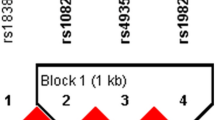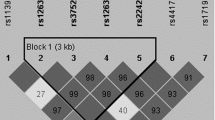Abstract
Purpose
Autoimmune thyroid diseases (AITDs) are chronic organ-specific autoimmune disorders, predominantly including Graves’ disease (GD), and Hashimoto’s thyroiditis (HT). This study aimed to investigate whether single-nucleotide polymorphisms (SNPs) in MAGI2 and MAGI3 gene contributed to the etiology of AITDs.
Methods
We conducted a case–control study including 1001 patients with AITDs (625 GD, 376 HT) and 846 healthy controls. Subgroup analyses in GD and HT were also performed.
Results
The genotypes of rs2160322 in MAGI2 showed a borderline association with AITDs (P = 0.048), and they had a strong correlation with GD (P = 0.012). The frequency of the minor allele G of rs2160322 was significantly higher in the GD patients than in the controls (P = 0.027; OR 1.91; 95% CI 1.020–1.391), especially for GD females (P = 0.008; OR 1.304; 95% CI 1.072–1.587), and those who had positive family history (P = 0.011; OR 1.412; 95% CI 1.083–1.843). For genetic model analysis, the recessive model and homozygous model of rs2160322 showed significant associations with AITDs (P = 0.009; P = 0.019) and GD (P = 0.004; P = 0.005). Nevertheless, our study could not identify any relationship between these SNPs and HT. Due to the low mutation rate of rs1343126 in MAGI3, we were unable to obtain a credible conclusion on its association with AITDs.
Conclusions
Our study identified that MAGI2 rs2160322 was strongly associated with GD susceptibility. The potential dysfunction of tight junction proteins and aberrant epithelial barrier caused by abnormal MAGI2 expression may be a novel mechanism of GD.
Similar content being viewed by others
References
De Leo S, Lee SY, Braverman LE (2016) Hyperthyroidism. Lancet 388(10047):906–918. https://doi.org/10.1016/S0140-6736(16)00278-6
Marino M, Latrofa F, Menconi F, Chiovato L, Vitti P (2014) An update on the medical treatment of Graves’ hyperthyroidism. J Endocrinol Investig 37(11):1041–1048. https://doi.org/10.1007/s40618-014-0136-z
Effraimidis G, Wiersinga WM (2014) Mechanisms in endocrinology: autoimmune thyroid disease: old and new players. Eur J Endocrinol 170(6):R241–R252. https://doi.org/10.1530/EJE-14-0047
Smith TJ, Hegedus L (2016) Graves’ Disease. The New England journal of medicine 375(16):1552–1565. https://doi.org/10.1056/NEJMra1510030
Jabrocka-Hybel A, Skalniak A, Piatkowski J, Turek-Jabrocka R, Vyhouskaya P, Ludwig-Slomczynska A, Machlowska J, Kapusta P, Malecki M, Pach D, Trofimiuk-Muldner M, Lizis-Kolus K, Hubalewska-Dydejczyk A (2018) How much of the predisposition to Hashimoto’s thyroiditis can be explained based on previously reported associations? J Endocrinol Investig. https://doi.org/10.1007/s40618-018-0910-4 (Epub ahead of print)
Marino M, Latrofa F, Menconi F, Chiovato L, Vitti P (2015) Role of genetic and non-genetic factors in the etiology of Graves’ disease. J Endocrinol Investig 38(3):283–294. https://doi.org/10.1007/s40618-014-0214-2
Menconi F, Marcocci C, Marino M (2014) Diagnosis and classification of Graves’ disease. Autoimmun Rev 13(4–5):398–402. https://doi.org/10.1016/j.autrev.2014.01.013
Tomer Y (2014) Mechanisms of autoimmune thyroid diseases: from genetics to epigenetics. Annu Rev Pathol 9:147–156. https://doi.org/10.1146/annurev-pathol-012513-104713
Szklarczyk D, Franceschini A, Wyder S, Forslund K, Heller D, Huerta-Cepas J, Simonovic M, Roth A, Santos A, Tsafou KP, Kuhn M, Bork P, Jensen LJ, von Mering C (2015) STRING v10: protein-protein interaction networks, integrated over the tree of life. Nucleic Acids Res 43(Database issue):D447–D452. https://doi.org/10.1093/nar/gku1003
Tsukita S, Yamazaki Y, Katsuno T, Tamura A, Tsukita S (2008) Tight junction-based epithelial microenvironment and cell proliferation. Oncogene 27(55):6930–6938. https://doi.org/10.1038/onc.2008.344
Rebuffat SA, Kammoun-Krichen M, Charfeddine I, Ayadi H, Bougacha-Elleuch N, Peraldi-Roux S (2013) IL-1beta and TSH disturb thyroid epithelium integrity in autoimmune thyroid diseases. Immunobiology 218(3):285–291. https://doi.org/10.1016/j.imbio.2012.05.016
Fang TJ, Lin CH, Lin YZ, Li RN, Ou TT, Wu CC, Tsai WC, Yen JH (2016) F11R mRNA expression and promoter polymorphisms in patients with rheumatoid arthritis. Int J Rheum Dis 19(2):127–133. https://doi.org/10.1111/1756-185X.12663
Miyagawa H, Yamai M, Sakaguchi D, Kiyohara C, Tsukamoto H, Kimoto Y, Nakamura T, Lee JH, Tsai CY, Chiang BL, Shimoda T, Harada M, Tahira T, Hayashi K, Horiuchi T (2008) Association of polymorphisms in complement component C3 gene with susceptibility to systemic lupus erythematosus. Rheumatology 47(2):158–164. https://doi.org/10.1093/rheumatology/kem321
Noren E, Mellander MR, Almer S, Soderman J (2018) Genetic variation and gene expression levels of tight junction genes indicates relationships between PTEN as well as MAGI1 and microscopic colitis. Dig Dis Sci 63(1):105–112. https://doi.org/10.1007/s10620-017-4857-7
Noren E, Almer S, Soderman J (2017) Genetic variation and expression levels of tight junction genes identifies association between MAGI3 and inflammatory bowel disease. BMC Gastroenterol 17(1):68. https://doi.org/10.1186/s12876-017-0620-y
McGovern DP, Taylor KD, Landers C, Derkowski C, Dutridge D, Dubinsky M, Ippoliti A, Vasiliauskas E, Mei L, Mengesha E, King L, Pressman S, Targan SR, Rotter JI (2009) MAGI2 genetic variation and inflammatory bowel disease. Inflamm Bowel Dis 15(1):75–83. https://doi.org/10.1002/ibd.20611
Yan N, Meng S, Song RH, Qin Q, Wang X, Yao Q, Jiang Y, Jiang W, Shi L, Xu J, Zhang J (2015) Polymorphism of IL37 gene as a protective factor for autoimmune thyroid disease. J Mol Endocrinol 55(3):209–218. https://doi.org/10.1530/JME-15-0144
Yan N, Meng S, Zhou J, Xu J, Muhali FS, Jiang W, Shi L, Shi X, Zhang J (2014) Association between STAT4 gene polymorphisms and autoimmune thyroid diseases in a Chinese population. Int J Mol Sci 15(7):12280–12293. https://doi.org/10.3390/ijms150712280
Yang J, Qin Q, Yan N, Zhu YF, Li C, Yang XJ, Wang X, Pandey M, Hou P, Zhang JA (2012) CD40 C/T(−1) and CTLA-4 A/G(49) SNPs are associated with autoimmune thyroid diseases in the Chinese population. Endocrine 41(1):111–115. https://doi.org/10.1007/s12020-011-9510-1
Gabrielson AT, Sartor RA, Hellstrom WJG (2018) The impact of thyroid disease on sexual dysfunction in men and women. Sex Med Rev. https://doi.org/10.1016/j.sxmr.2018.05.002
De Leo S, Pearce EN (2018) Autoimmune thyroid disease during pregnancy. Lancet Diabetes Endocrinol 6(7):575–586. https://doi.org/10.1016/S2213-8587(17)30402-3
McLeod DS, Cooper DS (2012) The incidence and prevalence of thyroid autoimmunity. Endocrine 42(2):252–265. https://doi.org/10.1007/s12020-012-9703-2
Goldstein J, Goyal R, Roland JT, Gellert LL, Clark PE, Hameed O, Giannico GA (2016) MAGI-2 is a sensitive and specific marker of prostatic adenocarcinoma: a comparison with AMACR. Am J Clin Pathol 146(3):294–302. https://doi.org/10.1093/ajcp/aqw111
Hirao K, Hata Y, Ide N, Takeuchi M, Irie M, Yao I, Deguchi M, Toyoda A, Sudhof TC, Takai Y (1998) A novel multiple PDZ domain-containing molecule interacting with N-methyl-d-aspartate receptors and neuronal cell adhesion proteins. J Biol Chem 273(33):21105–21110. https://doi.org/10.1074/jbc.273.33.21105
Ingham RJ, Colwill K, Howard C, Dettwiler S, Lim CS, Yu J, Hersi K, Raaijmakers J, Gish G, Mbamalu G, Taylor L, Yeung B, Vassilovski G, Amin M, Chen F, Matskova L, Winberg G, Ernberg I, Linding R, O’Donnell P, Starostine A, Keller W, Metalnikov P, Stark C, Pawson T (2005) WW domains provide a platform for the assembly of multiprotein networks. Mol Cell Biol 25(16):7092–7106. https://doi.org/10.1128/MCB.25.16.7092-7106.2005
Nagashima S, Kodaka M, Iwasa H, Hata Y (2015) MAGI2/S-SCAM outside brain. J Biochem 157(4):177–184. https://doi.org/10.1093/jb/mvv009
Wu X, Hepner K, Castelino-Prabhu S, Do D, Kaye MB, Yuan XJ, Wood J, Ross C, Sawyers CL, Whang YE (2000) Evidence for regulation of the PTEN tumor suppressor by a membrane-localized multi-PDZ domain containing scaffold protein MAGI-2. Proc Natl Acad Sci USA 97(8):4233–4238. https://doi.org/10.1073/pnas.97.8.4233
Hu Y, Li Z, Guo L, Wang L, Zhang L, Cai X, Zhao H, Zha X (2007) MAGI-2 Inhibits cell migration and proliferation via PTEN in human hepatocarcinoma cells. Arch Biochem Biophys 467(1):1–9. https://doi.org/10.1016/j.abb.2007.07.027
Tedelind S, Ericson LE, Karlsson JO, Nilsson M (2003) Interferon-gamma down-regulates claudin-1 and impairs the epithelial barrier function in primary cultured human thyrocytes. Eur J Endocrinol 149(3):215–221. https://doi.org/10.1530/eje.0.1490215
Antonelli A, Ferrari SM, Corrado A, Franceschini SS, Gelmini S, Ferrannini E, Fallahi P (2014) Extra-ocular muscle cells from patients with Graves’ ophthalmopathy secrete alpha (CXCL10) and beta (CCL2) chemokines under the influence of cytokines that are modulated by PPARgamma. Autoimmun Rev 13(11):1160–1166. https://doi.org/10.1016/j.autrev.2014.08.025
Nilsson M, Husmark J, Bjorkman U, Ericson LE (1998) Cytokines and thyroid epithelial integrity: interleukin-1alpha induces dissociation of the junctional complex and paracellular leakage in filter-cultured human thyrocytes. J Clin Endocrinol Metab 83(3):945–952. https://doi.org/10.1210/jcem.83.3.4626
Shirata N, Ihara KI, Yamamoto-Nonaka K, Seki T, Makino SI, Oliva Trejo JA, Miyake T, Yamada H, Campbell KN, Nakagawa T, Mori K, Yanagita M, Mundel P, Nishimori K, Asanuma K (2017) Glomerulosclerosis induced by deficiency of membrane-associated guanylate kinase inverted 2 in kidney podocytes. J Am Soc Nephrol JASN 28(9):2654–2669. https://doi.org/10.1681/ASN.2016121356
Li X, Li Z, Li N, Qi J, Fan K, Yin P, Zhao C, Liu Y, Yao W, Cai X, Wang L, Zha X (2013) MAGI2 enhances the sensitivity of BEL-7404 human hepatocellular carcinoma cells to staurosporine-induced apoptosis by increasing PTEN stability. Int J Mol Med 32(2):439–447. https://doi.org/10.3892/ijmm.2013.1411
Eng C (2002) Role of PTEN, a lipid phosphatase upstream effector of protein kinase B, in epithelial thyroid carcinogenesis. Ann N Y Acad Sci 968:213–221
Larson SD, Jackson LN, Riall TS, Uchida T, Thomas RP, Qiu S, Evers BM (2007) Increased incidence of well-differentiated thyroid cancer associated with Hashimoto thyroiditis and the role of the PI3k/Akt pathway. J Am Coll Surg 204(5):764–773. https://doi.org/10.1016/j.jamcollsurg.2006.12.037
Guaraldi F, Di Nardo G, Tarani L, Bertelli L, Susca FC, Bagnulo R, Resta N (2017) Association of autoimmune thyroiditis and celiac disease with juvenile polyposis due to 10q23.1q23.31 deletion: Potential role of PI3K/Akt pathway dysregulation. Eur J Med Genet 60(7):380–384. https://doi.org/10.1016/j.ejmg.2017.04.010
Grossman L, Chang C, Dai J, Nikitin PA, Jima DD, Dave SS, Luftig MA (2017) Epstein-Barr virus induces adhesion receptor CD226 (DNAM-1) expression during primary B-cell transformation into lymphoblastoid cell lines. mSphere 2(6):115–123. https://doi.org/10.1128/msphere.00305-17
Acknowledgements
The present work was supported by grants from the National Natural Science Foundation of China (nos. 81670722 and 81471004).
Author information
Authors and Affiliations
Corresponding authors
Ethics declarations
Conflict of interest
The authors declare that they have no conflict of interest.
Ethical approval
The experiment was approved by the ethics committee of Jinshan Hospital of Fudan University.
Informed consent
Informed consent was signed in both the patient group and the control group. All subjects in this experiment were voluntary and did not receive any financial compensation.
Rights and permissions
About this article
Cite this article
Jia, X., Zhai, T., Wang, B. et al. The MAGI2 gene polymorphism rs2160322 is associated with Graves’ disease but not with Hashimoto’s thyroiditis. J Endocrinol Invest 42, 843–850 (2019). https://doi.org/10.1007/s40618-018-0990-1
Received:
Accepted:
Published:
Issue Date:
DOI: https://doi.org/10.1007/s40618-018-0990-1




